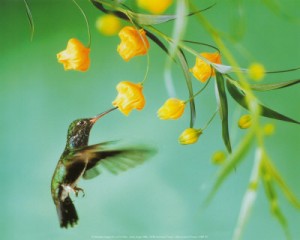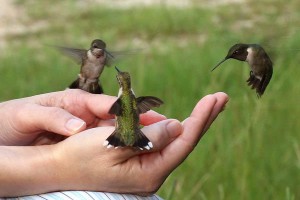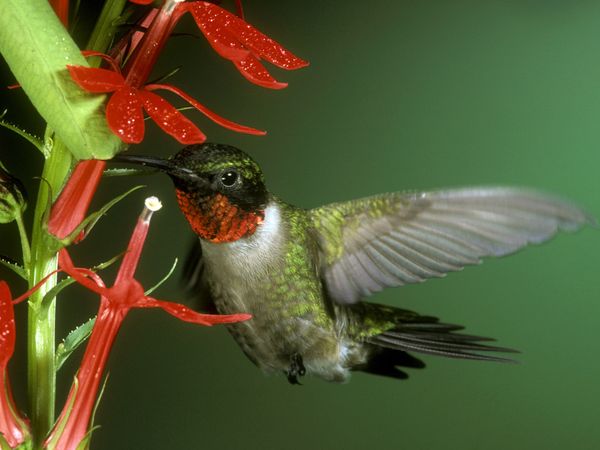It was a very windy day, with gusts approaching 75 kilometers per hour. You would think the hummingbirds would be hunkered down somewhere. But a small fleet of them put on an incredible show for me around the feeder in the backyard.
 As the wind whipped the trees and buffeted my face, six or eight of the tiny aerial acrobats at a time swooped, hovered, and dove with astounding agility on the swirling currents of air. They often buzzed within inches of my head, hovering for a few seconds at a time in front of my face.
As the wind whipped the trees and buffeted my face, six or eight of the tiny aerial acrobats at a time swooped, hovered, and dove with astounding agility on the swirling currents of air. They often buzzed within inches of my head, hovering for a few seconds at a time in front of my face.
And though my back was only a foot from the wall, they even did numerous high-speed loops around me, two or three at a time, as if I was a pylon in an air race. How are they able to fly with such precision in such high winds?
I sensed they appreciated my admiration of them. Despite their tiny brains, hummingbirds are obviously much more intelligent than I’d realized. Clearly they were responding to awareness and affection, though they weren’t consciously aware themselves.
All the while they took turns feeding on the sugar water at the feeder about a meter away. At one point, six landed at the same time, their miniscule claws clinging to the bar as the wind swayed the feeder back and forth. I’ve never seen more than two perch and drink simultaneously, so that too was quite a sight, and delight.
The show went on for a full 40 minutes, with each timeless minute bringing a deeper feeling of the hummingbirds’ inexhaustible joy. Indeed, as undivided, passive observation of the outer and inner movement grew into meditation, one realized that they embodied joy.
Self-knowing is the door to the infinite sublimity of life. However self-knowing is not a function of knowledge or accumulation, but of keen awareness of what one is actually thinking, feeling, and doing in the present moment? Most people think they know themselves, but few are self-knowing. We can never know ourselves; we can only be self-knowing because we’re changing all the time.
The hummingbird’s antics were so fast and there were so many of them that at times my eyes couldn’t follow. Humans must seem like lumbering giants to them in their tiny, high-speed existence. They struck me like children free to frolic to their hearts content in a pool on a perfect summer’s day. Through them there was a feeling them of a deeper, intrinsic intelligence in nature. Their joy was inexhaustible—what is its source?
With this experience fresh in mind, I went outside to greet the day early the next morning, as is my custom after waking. To my utter dismay, a hummingbird was caught in the feeder.
It was thrashing around trying to free itself, its tiny foot caught in one of the feeding holes. How long it had been ensnared I don’t know, but pinned between the circular landing bar and the container, a considerable number of its little feathers were smeared onto the base.
ensnared I don’t know, but pinned between the circular landing bar and the container, a considerable number of its little feathers were smeared onto the base.
For a moment I wished I’d never put up the feeder, but the non-fact gave way to the fact at hand. I took the diminutive bird firmly but gently in hand and extricated it from the inadvertent man-made trap. It had lost a lot of feathers on one wing. I brought it inside, as if that would help, wondering what to do. Should I take it to the nearby nature center? I felt certain its chances of survival were as small as the bird itself.
My concern for its welfare gave way to the rare experience of holding a living bird, much less a hummingbird in my hand. Setting aside my concern for its loss of feathers, trauma, and possible injury to its minuscule foot and leg, I studied it.
The hummingbird had a rakish strip of bright blue on its wings, but lacked the fluorescent throat coloration that many of its kind have in this clime. I could feel its wee heart beating incredibly fast. But it didn’t struggle, clearly exhausted by its ordeal.
The sun was shining, and I decided to set the wounded creature on a cross section of the fence, and go get some breakfast. To my astonishment, when I returned 20 minutes later, the bird was preening on the grass next to the fence. When I returned another 20 minutes later, it was gone.
Not having seen any cats in the vicinity of late, and with no further loss of feathers or signs of struggle, the likeliest explanation was that it somehow managed to fly away.
It struck me viscerally how life and death are part of the seamless dance of life. And how only humans, when we kill and eat animals needlessly, separate themselves from the natural world out of which we evolved along with all other life.
Different languages divide people, but there’s a language of being that all creatures share, which human beings can hear and speak when our separative tongues are silent.
Martin LeFevre

